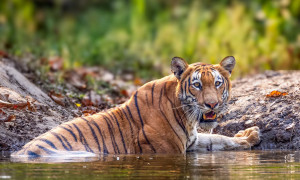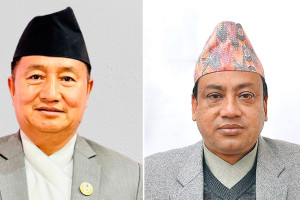Miscellaneous
Rapti River welcomes 25 Gharials
Nature conservationists and a zoological society have released 25 Gharials into Rapti River. The National Trust for Nature Conservation, Chitwan and Zoological Society of London in Nepal released the crocodiles on Friday to help preserve the endangered species of crocodiles.
Nature conservationists and a zoological society have released 25 Gharials into Rapti River. The National Trust for Nature Conservation, Chitwan and Zoological Society of London in Nepal released the crocodiles on Friday to help preserve the endangered species of crocodiles. The two bodies sourced the crocodiles from the crocodile breeding centre in Chitwan National Park, a Rastriya Samachar Samiti report said on Saturday.
The Gharial (Gavialis gangeticus), is one of the longest of all living crocodilians, measuring up to 6.25 m (20.5 ft), though this is the upper limit, as the average adult Gharial is only 3.5 to 4.5 m (11 to 15 ft) in length The act of releasing crocodiles into the natural habitat this time was carried out differently, with the involvement of the local Bote, Majhi and Musahar communities.
The crocodiles were marked as per the three communities in a symbolic way to help preserve the endangered species. This new way of marking the crocodiles was carried out with the objective of increasing the awareness of the locals in the conservation and preservation of wildlife, said Chitwan National Park Protection Officer Bed Bahadur Khadka.
The Gharial species of crocodiles are now limited to Chitwan and Bardia only and so far more than 1,000 Gharials were released into the rivers. Only few have survived. Latest census says there are only 198 crocodiles in Nepali rivers.
The crocodile breeding centre in the park has 595 crocodiles at present. The authorities plan to release around 100 of them into their natural habitat this year.
Romulous Whitaker and members of the Gharial Multi-Task Force, Madras Crocodile Bank, write in their March 2007 publication under the chapter ‘The Gharial: Going Extinct Again’, “This remarkably gentle animal once thrived in the deep rivers of India, Nepal, Pakistan, Bangladesh, Bhutan, and Myanmar, it is now virtually extinct in all but the first two of these countries, where it is limited to 2 percent of its former range.”
Whitaker is an Indian herpetologist, wildlife conservationist and founder of the Madras Snake Park, The Andaman and Nicobar Environment Trust (ANET), and the Madras Crocodile Bank Trust.
The Gharial thrived in all the major river systems of the Indian Subcontinent, spanning the rivers of its northern part from the Indus River in Pakistan across the Gangetic floodplain to the Irrawaddy River in Myanmar. Today, it is extinct in the Indus River, in the Brahmaputra of Bhutan and Bangladesh, and in the Irrawaddy River. Its distribution is now limited to only 2% of its former range, writes Whitaker.
Early records for the Gharial are mainly anecdotal. Old references indicate the Gharial’s abundance: common in the Indus River in Pakistan (Francis 1910, Rao 1933); Gandak River in Nepal (IAK 1921); Jumuna River in Uttar Pradesh (Hornaday 1885), and Kosi River in Bihar (Shortt 1921).
By 1976, the estimated total population of wild Gharials had declined from an inferred 5,000–10,000 animals in the 1940s and throughout its huge former range (spanning the rivers of the northern part of the Indian Subcontinent from the Indus in present-day Pakistan 3000 km eastward across the Gangetic floodplain to the Irrawady in Myanmar) to fewer than 200 (Whitaker 1974), a decline of about 96 percent, writes the herpetologist.




 26.37°C Kathmandu
26.37°C Kathmandu











